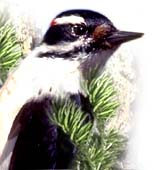Ponderosa Pine
Restoration
Since 1998, RMBO has been investigating the effects of ponderosa pine
restoration activities on breeding bird populations in the San Juan National
Forest. This project is part of a larger effort to demonstrate methods for
returning ponderosa pine forests to a pre-Columbian state. Participants in the
Ponderosa Pine Forest Partnership include Montezuma County, U.S. Forest
Service, Colorado Division of Wildlife, Colorado State University, and the
Colorado Timber Industry Association. This collaborative effort aims to develop
a sound restoration prescription via adaptive management—attempting new
management methods, analyzing the outcome, and modifying subsequent efforts so
as to develop a restoration prescription that accomplishes the goals of the
Partnership.
More than 100 years of fire suppression, grazing, and timber harvesting in
ponderosa pine forests have produced a forest structure that differs greatly
from pre-Columbian forests. Historically, frequent low-intensity fires
maintained an open forest of large trees with a vigorous understory of grasses
and herbaceous plants. Compared to pre-Columbian ponderosa forests, modern
forests in the Southwest have more trees, smaller trees, fewer large snags,
more continuous (less patchy) tree distribution, more oak scrub, and less forb
and grass cover. A forest in this condition supports a bird community unlike
that of the more open pre-Columbian forest. Restoring modern ponderosa forest
to pre-Columbian conditions requires a management prescription of thinning to
remove excessive stems, retaining the largest trees, retaining trees in
clusters, and implementing periodic prescribed burns to rejuvenate the
understory and to regulate the density of young woody plants.
We are working in five demonstration areas to determine the response of the
avian community to application of the restoration prescription. We used point
counts to survey the bird communities in areas that had been thinned and burned
and in nearby undisturbed areas, and compared the results. So far, we have
found no wholesale changes in the bird community - nearly all species that were
present in the undisturbed areas were also present in the thinned and burned
areas. Only the abundances changed. In general, birds that prefer more open
forests, including aerial foragers like the Western Bluebird and Violet-green
Swallow, were more abundant in the treated areas. This study is quite timely,
given the growing interest in thinning and burning Western forests after the
wildfires of recent years. RMBO is making valuable contributions to the
development of a forest management technique that will become more widespread
in the years to come.
For More Information:
scott.gillihan@rmbo.org
230 Cherry Street
Fort Collins, CO 80521
(970) 482-1707



